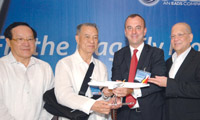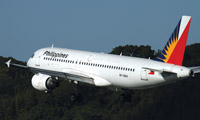News Backgrounder
Record fleet order for PAL
Now the airline wants to build its own airport
October 1st 2012
When Philippine Airlines (PAL) president, Ramon S. Ang, signed the biggest aircraft order in the Philippines’ history with Airbus in August to buy 54 new jets worth US$7 billion, he dropped an unexpected bombshell. Read More »
 |
| Pictured at the Airbus signing ceremony from left are: PAL vice-chairman and treasurer, Harry C. Tan, PAL chairman, Lucio Tan, Airbus senior vice-president for Asia, Jean Francois Laval, and PAL president, Ramon Ang. |
PAL wants to build its own airport. The airline, he explained, is ready to contribute $500 million to help fund the project, with the remainder of the cost financed with loans from foreign or local banks.
While Ang faces major hurdles to turn the dream into reality, which includes gaining government approval for the project and acquiring 2,000 hectares of land, the announcement makes clear that PAL’s new controllers are serious about reviving the carrier’s fortunes.
There are signs that PAL is on an upswing. After a year of labour strife and high fuel prices, PAL reported a net loss of $99.79 million in the year ended March 31. But its bottom line turned black in the first quarter (ended June 30) of the current year with a profit of $11.4 million, compared to a loss of $10.6 million in the same period in 2011.
Since the announcement of the Airbus order for 10 long-haul A330-300s and 44 A321s, Ang has boosted staff morale by declaring the fleet expansion means PAL will embark on a recruitment drive.
It is good news for the airline’s 4,800 workforce, who last year saw 2,400 staff laid-off and another 500 retrenched after PAL’s ground handling, ticket reservations and catering operations were outsourced as part of a rationalization plan.
Ang said the airline will need to double the number of flight attendants and hire more pilots as well as other staff. “There is no need for PAL to cut more employees. We will hire new workers,” he said. PAL has 460 pilots, about 1,600 cabin crew and more than 2,700 other employees.
Ang’s diversified San Miguel conglomerate bought a 49% stake in PAL, owned by Philippine tobacco tycoon, Lucio Tan, for $500 million in April. Tan remains chairman and chief executive, but San Miguel has taken management control with Ang as president and chief operating officer.
 |
| Philippine Airlines: record order |
At the airline’s recent annual shareholder meeting Tan said: “Despite multiple challenges last year, PAL stayed the course and dramatically restructured its operations, enabling your airline to attract much needed strategic investments and prime itself for a sustained push in the years ahead.”
Ang, often described as a maverick businessman, has a long record of successfully turning troubled companies around.
In recent years, he has transformed San Miguel, changing its strategic path from its core businesses of food and beverage into a huge corporation with interests in power, mining, petroleum, infrastructure and telecommunications.
PAL is its first foray into the airline sector and Ang has vowed to turn its fortunes around in a year.
“PAL is a good airline and brand. We’re confident we can turn PAL and its sister budget carrier, Air Philippines, around in a year,” he said. A full return to profitability will be achieved through the implementation of a better sales and ticketing system and reduction in costs through higher aircraft utilization, he added.
PAL has 39 aircraft comprising of five B747-400s, three B777-300ERs, four A340-300s, eight A330-300s, 15 A320-200s and four A319-100s. Four more B777-300ERs are scheduled for delivery through 2013 and 2014.
Delivery of the recently announced Airbus jets will begin next year. “The orders we are placing will play a key role in revitalizing PAL and growing trade and tourism in the country,” said Ang. “At the same time, we will benefit from the low operating costs associated with new generation aircraft and the reduced impact on the environment.”
Ang said PAL needs another 46 planes to bring its new aircraft orders to a planned100. He indicated 26 of the remaining 46 would be long-haul aircraft capable of 17 hour flights from Manila to destinations such as New York and Paris. “We are looking at B777-300ERs and the upcoming B777-X. We’re also interested in the B787-9 Dreamliner,” he said.
His greatest challenge will be the planned new airport. Ang won’t give full details of the project cost and location, but said it would be 15 minutes away from the Manila suburb of Makati, where PAL is headquartered.
He believes construction can start as early as next year and the facility, with a terminal for the exclusive use of PAL and its budget sister Air Philippines, can be completed in three years.
The Philippines needs a new airport because Manila’s Ninoy Aquino International Airport (Naia) in Pasay City, built in the 1950s, can handle only 36 flights an hour and is regarded as obsolete.
The government plans to turn the former Clark U.S. air base, some two hours drive from the capital, into the country’s premier gateway.
Ang said PAL’s new facility, which will initially have two parallel runways with space for two more, would have the capability of being able to handle four times as many flights as Naia.
“We still have to clear this with the government, but we are hoping they will support us. We plan to pitch this to President Aquino in January or February. Hopefully, this is aligned with the government’s plans,” he said.
In the meantime, the signs for 2012-13 are positive for PAL. After its profitable first quarter, July was also profitable.
The carrier has gained stability, increased its yields, load factors and cargo volumes. Fuel, which last year was 43.8% of its operating expenses, has eased in price and passenger volumes are rising.
U.S. frustration for PAL
Philippine Airlines has another major hurdle to overcome if it is to make full use of its new fleet.
It is now more than two years since the U.S. Federal Aviation Administration (FAA) downgraded the Philippines to CAT 2 status because of safety concerns.
The restriction is directed at the regulator, the Philippines Civil Aviation Board (CAB), for its lack of safety oversight. But the move also penalises PAL because as part of the downgrading the national carrier cannot add new destinations in the U.S. or change the aircraft type it uses.
The CAB is continuing to work with the FAA and the International Civil Aviation Organisation (ICAO) on improving its oversight, but there is no immediate word on when the Philippines will be reinstated to CAT 1.
However, Orient Aviation understands it is hoped the situation can be resolved by later this year or in the first half of next year in time for the first deliveries of the new Airbus aircraft.